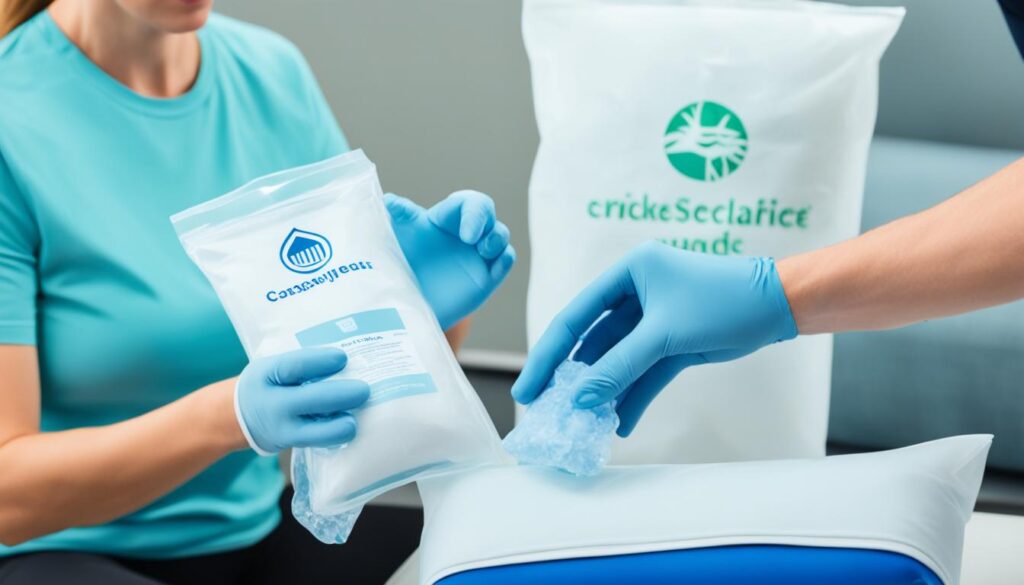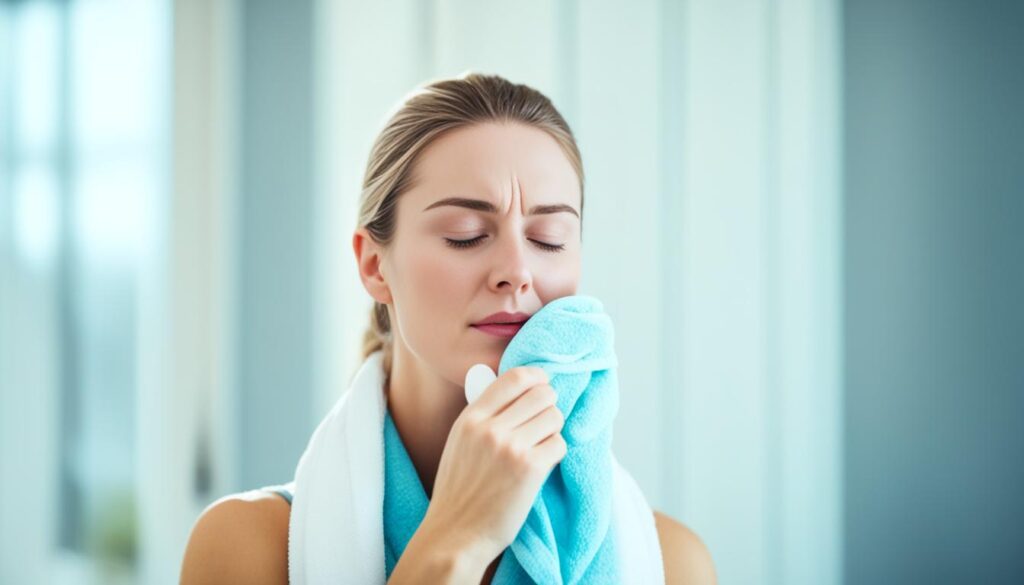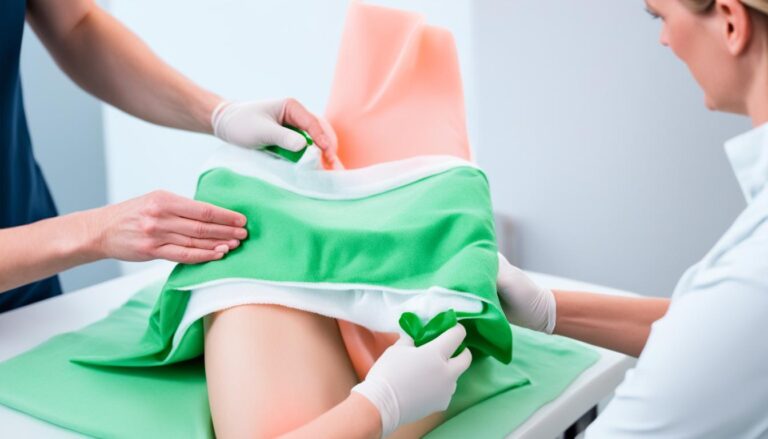In the quest for pain relief and healing, hot and cold therapy work wonders. This guide shows you how to make your own compresses at home. It covers the types, benefits, needed materials, and how to use them correctly. Whether you face chronic pain or have an injury, using hot and cold compresses wisely can truly help.
This guide will give you the info and confidence you need. Learn about the soothing warmth of hot compresses and the refreshing cold of cold compresses. You’ll learn about making your own, the benefits, the right materials, how to use them, and staying safe. By using these methods correctly, you can boost your health and healing for many conditions.
### Key Takeaways
– Hot compresses boost blood flow and unwind tight muscles, easing chronic pain and stiffness.
– Cold compresses cut down on swelling and inflammation, helping with new injuries and after workouts.
– It’s vital to apply them properly and follow safety tips to prevent harm to your skin.
– You can make a hot or cold compress from common items at home, like a heating pad or an ice pack.
– Using both hot and cold therapy can make a big difference in how you deal with pain, heal, and feel better overall.
Understanding Hot and Cold Therapy
Heat and cold therapy, or thermotherapy and cryotherapy, play a big part in healthcare. They help with muscle and joint problems. Knowing how each one works helps us use them right.
How Heat Therapy Works
Heat therapy boosts blood flow and warms up the area being treated. This can make muscle pain feel better and keep you more flexible. There’s wet heat, like warm towels, and dry heat, like a heating pad. Both kinds make blood flow better, helping you heal and feel less pain.
How Cold Therapy Works
Cold therapy, or cryotherapy, does the opposite. It lessens blood flow to reduce swelling and pain. It also numbs the area, easing the discomfort. Using ice packs or cool water is common. Cold therapy is good for new injuries or after working out, as it helps with swelling and speeds up recovery.
Benefits of Hot Compresses
Hot compresses have many good effects. They help with various muscle and joint issues by boosting blood flow. This means more nutrients and oxygen get to the sore spot, which speeds up healing. The heat also loosens tight muscles, cutting down on pain and stiffness.
Improved Blood Circulation
Heat on an area makes the blood flow there increase. This brings more oxygen and nutrients to heal the spot. It also helps reduce swelling and makes tissues repair faster. By getting rid of waste, heat can lower pain as well.
Muscle Relaxation
The warmth from hot compresses eases muscle tension and spasms. This makes us feel more relaxed, loosening up our movements. Muscle relaxation is a big help for issues like chronic back pain and arthritis, making our daily life better.
Pain Relief
Heat eases pain right where it hurts by calming nerve endings. This cuts down on pain signals to our brain. It works well for sudden injuries and long-lasting joint or muscle pain. The result is that we feel better almost right away.
Benefits of Cold Compresses
Hot compresses help with chronic pain, but cold therapy has its own benefits. It works by narrowing blood vessels, which lowers blood flow. This helps reduce inflammation and swelling around injuries or sore spots. It is very effective for acute injuries, like sprains.
Cold therapy also feels cool on the skin, which can numb pain by slowing down nerve signals. This pain numbing quality is good for easing short-term discomfort. Cold compresses are great for handling muscle and sports injuries.
Types of Hot Compresses
With hot compresses, you can pick between dry heat and moist heat. Each type has its own benefits and best uses. This lets people choose what works for them, matching their heat therapy to what they need.
Dry Heat Sources
Hot compresses that use dry heat include heating pads, dry packs, and saunas. They are easy to use and bring heat right where it’s needed. With heating pads and dry packs, you get to set the exact heat level and time. They fit nicely into your routine.
Moist Heat Sources
Moist heat comes from things like steamed towels, moist packs, and soaking in a hot bath. It might work a bit better than dry heat. And you need to use it for a shorter time to get the same good effects. The extra moisture helps the heat reach deeper into your tissues. That could mean more relief and healing faster.
Types of Cold Compresses
There are two main kinds of cold therapy for pain relief: ice packs and cold water compresses. They both work by cooling down the area, which reduces swelling and numbs the pain.
Ice Packs
Ice packs are very popular for easing pain. You can use a bag of frozen peas or a special gel ice pack. They help by making blood vessels smaller, which reduces how much blood flows to the area. This cuts down on swelling and makes the area feel numb, calming the pain.
Cold Water Compresses
Cold water compresses are simple to make. You just need a towel or a washcloth and cold water. Soak the fabric in the cold water and put it on your skin. It works just like ice packs, reducing swelling and numbing the pain. Plus, it’s something anyone can do at home.
Making Hot and Cold Compresses: A Guide
Want to deal with health issues at home? Making your own hot and cold compresses is easy and budget-friendly. This guide will show you how to do it step by step. With just common items from your home, you can soothe achy muscles and joints. You’ll also find out the best ways to use these compresses safely for max relief.
Are you looking for ways to ease muscle pain, joint soreness, swelling, or quick injuries? Learning to craft hot and cold compresses is key. The methods we share here will let you create compresses that fit your unique needs.

This guide details everything from choosing the right materials to using the compresses correctly. You’ll learn all about crafting hot and cold compresses. Whether you prefer dry heat, moist warmth, cold packs, or water soaks, you’ll know how to do it right. This know-how will help you get the best comfort and healing.
Ready to learn how to make your own hot and cold compresses? This step-by-step guide is here to show you. By making these at home, you’re choosing a simple, affordable way to manage pain and heal naturally.
Materials for Hot Compresses
Hot compresses need the right things for them to work. You’ll need heating pads, hot water bottles, and different kinds of towels and washcloths. These things help give heat, which warms up the area that needs it.
Heating Pads
Heating pads give off dry heat for specific parts of your body. They come in many sizes and heat levels, so you can pick what’s best for you. It’s important to use them the right way to make sure you’re safe and they work well.
Hot Water Bottles
Hot water bottles are a classic hot compress option. You fill a rubber or silicone bottle with hot water. Then, you can put it on sore spots or muscles. They’re easy to use and let you adjust how much heat you need.
Towels and Washcloths
Towels and washcloths are also key for hot compresses. You can make moist heat compresses with them. To do this, soak the cloth in hot water. Then, place it on your skin. This gives a warm, moist feeling that goes into the muscle to help feel better.
Materials for Cold Compresses
Creating a good cold compress involves smart choices. Ice packs and gel packs both do a great job. They cool the skin fast and help lower swelling and pain. Also, bags of frozen veggies, like peas or corn, are easy to use and budget-friendly.
Ice Packs and Gel Packs
Ice packs and gel packs you can use again are good for injuries. They freeze like ice and cool a certain area well. This helps reduce swelling in muscles and joints.
Frozen Vegetables
Using frozen veggies in a bag is simple and cheap. This method is as good as ice packs. The veggies can shape around the body, fitting where it’s needed. Plus, they keep the cold for a while.
Cold Water and Towels
Cold water and a towel can be a great cold compress too. Wet a clean towel in cold water and put it on the skin. This cools big areas and can work on the head for headaches. Just make sure the towel stays cold and wet.
To make the best cold compress, use the right materials wisely. Have ice packs, gel packs, frozen veggies, and cold water ready. They can help with many health problems fast and safely.
Application Techniques for Hot Compresses
Getting hot compress application right is important for good results and safety. Using a warm, not too hot, compress is key to prevent skin burns. Keep localized heat under 20 minutes to avoid hurting your skin.
For hot compress use, sessions can be short or long. For mild discomfort, 15-20 minutes is enough. But for serious pain, you might need to go from 30 minutes up to 2 hours. Always watch how long you’re exposing your skin. If the pain doesn’t improve or if it gets worse after a week, see a doctor.
Make sure the heat spreads well where it’s needed when using hot compresses. You can do this with dry (heating pads) or moist heat (steamed towels). A study from 2013 showed moist heat can lessen muscle pain much faster than dry heat. So, using moist heat might help you feel better sooner.
| Application Technique | Recommended Duration | Effectiveness |
|---|---|---|
| Dry Heat (e.g., Heating Pads) | 15-20 minutes for minor issues, up to 2 hours for severe pain | Effective, but may require longer application times compared to moist heat |
| Moist Heat (e.g., Steamed Towels) | 15-20 minutes for minor issues, up to 2 hours for severe pain | More effective than dry heat, especially for deep muscle pain, and can provide relief in a shorter time |
Sticking to these proper hot compress application steps can be very helpful. It’s a good way to use heat therapy for many issues, like muscle pain, joint stiffness, or swelling.
Application Techniques for Cold Compresses
Properly using cold compresses is key to making them work well. We want to get all their benefits without hurting our skin or tissues. This part will go through how to use cold therapy. It includes things like using ice, cold water immersion, and contrast baths.
Icing Techniques
Using ice packs or gel packs is a go-to for cold therapy. Always wrap them in a thin towel first. This keeps the cold from hurting your skin. You shouldn’t ice for more than 10 to 15 minutes at a time. Doing it too much can cause problems for your nerves and skin.
Cold Water Immersion
Putting a body part in cold water is another good way to use cold therapy. It works by making the blood vessels smaller, which reduces swelling. Use water that’s cool but not painfully cold. And don’t do it for more than 10-15 minutes.
Contrast Baths
Contrast baths mix hot and cold water to help your blood flow better. This can lower pain and swelling and help you heal faster. Start by soaking in warm water for 3-5 minutes. Then switch to cold for 1-2 minutes. Do this back and forth a few times.

Safety Precautions for Hot and Cold Compresses
Using hot and cold compresses requires careful steps to avoid harm. By knowing and following safety tips, you can safely treat yourself. This way, you get the benefits without the risks.
Avoiding Burns and Skin Damage
Burns and skin damage are key worries when using these compresses. Always be careful with the temperature and keep it off bare skin. A towel layer between the compress and your skin is a must. It makes sure it’s safe for you.
Monitoring Treatment Duration
How long you use hot and cold treatments is very important. For heat, stick to 15 to 20 minutes for light cases. For serious pain, you can go up to two hours. With cold, use it for 10 to 15 minutes a few times a day. Make sure it doesn’t go over 20 minutes to avoid issues.
Contraindications and Precautions
Some situations make hot or cold therapy unsafe. This includes people with certain health problems. If you have diabetes, skin issues, or heart problems, be careful. Always talk to your doctor if you’re unsure.
If heat makes swelling worse or doesn’t help in a week, see a doctor. And if cold doesn’t reduce pain in 48 hours, you should also consult a healthcare provider.
When to Use Hot Compresses
Hot compresses work well for chronic pain and stiffness. They are also great for muscle spasms and tension. Heat therapy boosts blood flow and warmth. This helps make tight muscles relax. It also eases soreness and speeds up healing where there’s long-term pain.
Chronic Pain and Stiffness
People with chronic pain and stiffness, like from osteoarthritis or fibromyalgia, find hot compresses helpful. The use of low-level, long-term heat decreases stiffness and tension. It makes their joints and muscles more flexible. The effects can last for 48 hours after the heat is applied.
Muscle Spasms and Tension
If you have muscle spasms and tension, hot compresses can help too. The heat boosts blood circulation, calming the muscles. This also helps the damaged tissue heal. Using heat wraps for up to 8 hours, even at night, can also ease discomfort. It depends on what your doctor recommends for your specific condition.
Using hot compresses as part of your daily care can do a lot. It can help manage chronic pain and muscle problems. People often see better flexibility and less pain in the areas they target.
When to Use Cold Compresses
Cold compresses work best for acute injuries and inflammation. They help lower blood flow and swelling. This reduces pain and speeds up healing in spots hurt by recent injury or overuse. Cold compresses are great for sprains, strains, and other acute musculoskeletal conditions.
Acute Injuries and Inflammation
Cold compresses are key for acute injuries and inflammation. They cut off blood flow to the hurt area. This reduces swelling and inflammation, key symptoms of new injuries. So, they are excellent for treating sprains, strains, and similar issues.
Post-Exercise Recovery
Cold compresses are not just for new injuries. They also help in post-exercise recovery. After a tough workout, the cold can lessen inflammation and muscle pain. This helps the body heal faster. Using cold compresses on muscles can make you feel less sore, aiding a quicker return to normal activities.
Conclusion
We covered everything you need to know about hot and cold compresses. This guide explains how to make and use them for better health. Knowing their advantages, types, materials, and how to use them helps you add these tools to your care routine. You can use them for all sorts of issues like long-lasting pain or sudden injuries.
When you use hot and cold packs, safety is key. Be careful not to use them too hot or cold. Always put something between the pack and your skin. Also, don’t use them for too long in one go. If your problem doesn’t get better or gets worse, see a doctor for advice.
This hot and cold compress guide has summed up the most important details. Now you know how to decide when and how to use heat and cold treatments. By following the conclusion and advice here, you’re taking the first step in your care journey. You’re on your way to enjoying the benefits of these great therapies.


